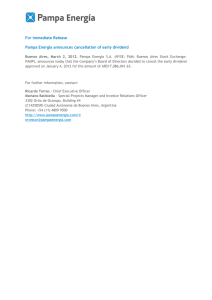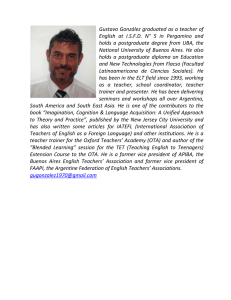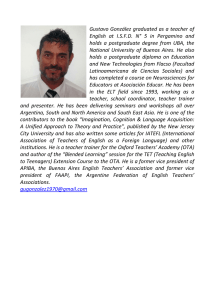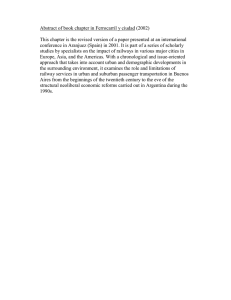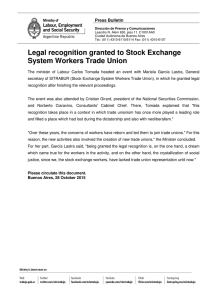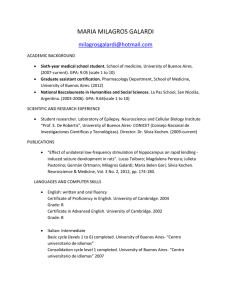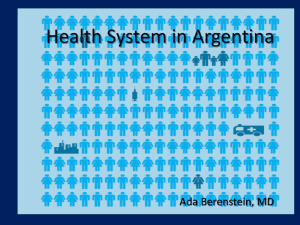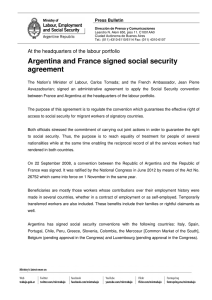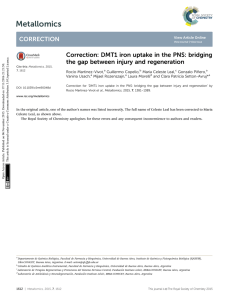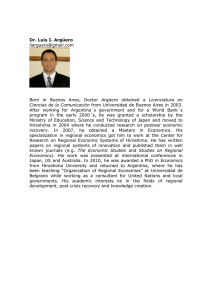C.V. - Art Miami
Anuncio
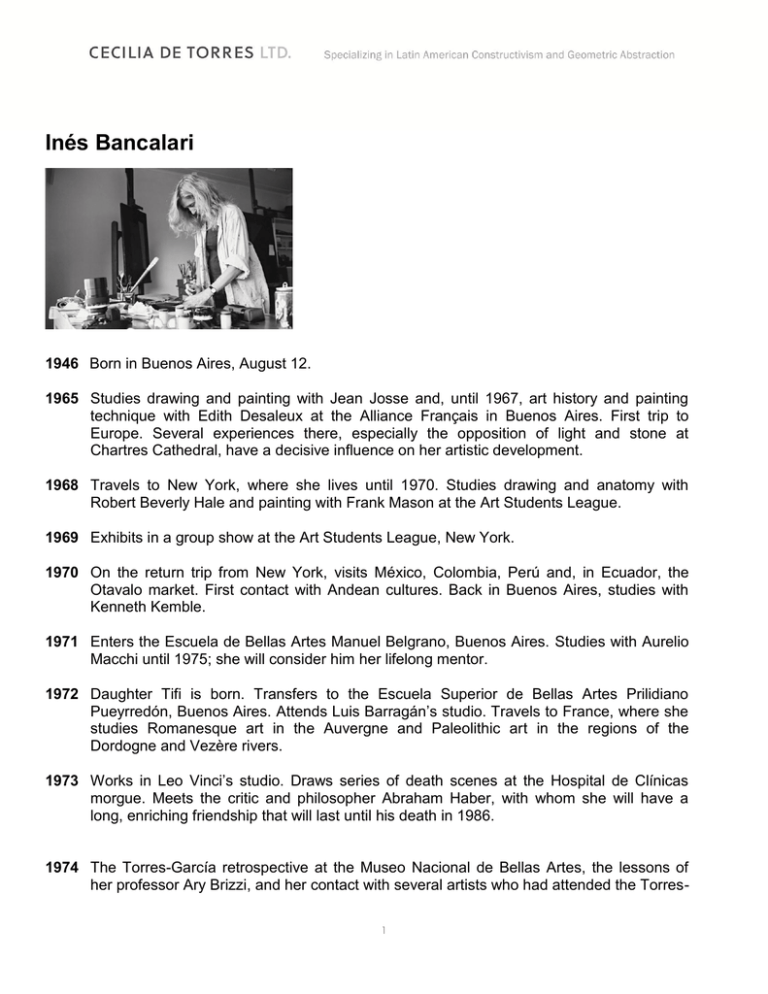
[Type text] Inés Bancalari 1946 Born in Buenos Aires, August 12. 1965 Studies drawing and painting with Jean Josse and, until 1967, art history and painting technique with Edith Desaleux at the Alliance Français in Buenos Aires. First trip to Europe. Several experiences there, especially the opposition of light and stone at Chartres Cathedral, have a decisive influence on her artistic development. 1968 Travels to New York, where she lives until 1970. Studies drawing and anatomy with Robert Beverly Hale and painting with Frank Mason at the Art Students League. 1969 Exhibits in a group show at the Art Students League, New York. 1970 On the return trip from New York, visits México, Colombia, Perú and, in Ecuador, the Otavalo market. First contact with Andean cultures. Back in Buenos Aires, studies with Kenneth Kemble. 1971 Enters the Escuela de Bellas Artes Manuel Belgrano, Buenos Aires. Studies with Aurelio Macchi until 1975; she will consider him her lifelong mentor. 1972 Daughter Tifi is born. Transfers to the Escuela Superior de Bellas Artes Prilidiano Pueyrredón, Buenos Aires. Attends Luis Barragán’s studio. Travels to France, where she studies Romanesque art in the Auvergne and Paleolithic art in the regions of the Dordogne and Vezère rivers. 1973 Works in Leo Vinci’s studio. Draws series of death scenes at the Hospital de Clínicas morgue. Meets the critic and philosopher Abraham Haber, with whom she will have a long, enriching friendship that will last until his death in 1986. 1974 The Torres-García retrospective at the Museo Nacional de Bellas Artes, the lessons of her professor Ary Brizzi, and her contact with several artists who had attended the Torres1 García Workshop, have a profound, if not immediate influence on her concept of color, especially in the treatment of grays. Receives first prize in the Cinta de Plata competition; Exhibits at the Casa Central de los Ferrocarriles Argentinos, in Buenos Aires, and at the Casa de la Cultura, in Salta. Visits the provinces of Jujuy and Salta. Retiro, mu jeres, 1976 ink on paper 4¾ x 6¼ in. 12 x 16 cm Morgue I, 1973, ink on paper, 13⅜ x 1 7⅞ in. 34 x 45, 5 cm 1976 Series of drawings and paintings of Retiro Station. In June 1976, she writes, “On the train again, it is 11.45 pm. I just got out of class. At every station there are one or more soldiers with rifles. I always draw for a while, at night, some women who sleep in the corners, on the floor, wrapped in plastic bags, and others in the waiting room. They return each day, but are not waiting for anything, or anyone; they remind me of Samuel Beckett’s Waiting for Godot...” Graduates as valedictorian from the Escuela Superior de Bellas Artes Prilidiano Pueyrredón. Teaches in schools and at her studio, a task she will continue for 15 years. Abraham Haber teaches classes in art history and Carl Jung’s thought at her studio. First one-woman show at the Van Riel Gallery, Buenos Aires. Starting this year, she participates regularly in group exhibitions. Works in the Boca neighborhood of Buenos Aires in a studio at Magallanes 945. 2 La pava celeste, 1977, oil on canvas, 19¾ x 27½ in., 50 x 70 cm. 1977 On a train she meets Juan and Silvio Barbetti, who become her models. She draws and paints them at their cabin, on an island of the Tigre Delta, and at the San Fernando Hospital, where they die in 1978. Works on the series of harbor scenes. Awarded second prize at the V Salón Alba de Pintura at the Velázquez Gallery, and exhibits at the LXVI Salón Nacional, both in Buenos Aires. Puerto I, 1977, oil on hardboard,11¾ x 15⅛ in., 30 x 38,5 cm. Juan II, 1978, oil on hardboard, 31½ x 23⅝ in., 80 x 60 cm. 1978 One-woman shows at the CEDA Foundation, Washington, DC, at the Van Riel Gallery, and at the Sur Gallery, both in Buenos Aires. Participates in group exhibitions at the XIV Salón Municipal in Mar del Plata, Buenos Aires Province and at the Salón de Rosario, Museo Municipal J.B. Castagnino, Rosario, Santa Fé Province. In Buenos Aires, group shows at the LXVII Salón Nacional de Pintura, the XIV Salón de Grabado y Dibujo, and the Sociedad Hebraica Argentina. 3 1979 One-woman exhibition at the Museo de Bellas Artes de La Rioja, Octavio de la Colina in the city of La Rioja. Visits the provinces of Tucumán, Catamarca and La Rioja, discovering the archeological wealth of the region, including Talampaya, with its petroglyphs. Interested in Alberto Rex González´s research of pre-Columbian cultures, frequents the Museo de Ciencias Naturales de La Plata. The metal grays of the ceramics, their geometric design, their surface incisions and the stone masks, will influence her painting, especially her first constructivist works. Upon her return to Buenos Aires, she begins the series of Still Lives. Participates in group shows at the Salón Municipal de Pintura and at the Muestra de Pintura Joven at the Praxis Gallery, both in Buenos Aires. Maceta,1979, oil on canvas, 32¼ x 28⅜ in., 82 x 72 cm. 1980 Continues the series of portraits begun in 1973, paints portraits of Ana. Meets Alfredo Hlito in the offices of Horizonte magazine. Invited by the Sarmiento Gallery, Buenos Aires, for a one-woman show. Haber writes the essay in the accompanying catalogue. Exhibits at the Salón Anual de Santa Fé, Museo Rosa Galisteo de Rodríguez, Santa Fé Province. 1981 Travels to Catalonia, where she stays for a month drawing and studying Romanesque frescos, sculpture and cloisters. Invited by the Equipo Teatro Payró, under the direction of Jaime Kogan, she creates a series of paintings and drawings based on rehearsals for Chekhov’s Ivanov. One-woman shows at the Museo de Bellas Artes de Junín, Buenos 4 Aires Province and at the Banco Popular Argentino, Buenos Aires. 1982 Draws in the Once train station and neighborhood: the waiting room, the bars, the arcades, and the street. She sketches with pencil, charcoal and ink. Back in her studio, she paints a series of expressionist works based on these impressions that she calls Urban Landscapes – Human Landscapes. Recova (Arcade), Familia (Family), Prostituta (Prostitute), Hombre (Man). One-woman show at the Payró Theater in Buenos Aires. Ivanov I, 1982, pastel on paper, 19¾ x 27½ in., 50 x 70 cm. Ivanov II, 1982, ink on paper, 12⅝ x 7⅞ in., 32 x 20 cm. 1983 Moves her studio to Victoria, Buenos Aires Province. First abstract drawings, studies of mineral shapes from the rivers of Córdoba and San Luis. Shows twenty-four oil paintings in the exhibition, Nuevos Valores de la Pintura Argentina, Museo de Quilmes in Buenos Aires Province, and fifteen paintings from the Ivanov series at the Fondo Nacional de las Artes in Buenos Aires. Participates in the Salón de Santa Fé, Santa Fé Province. La Recova, 1983 oil on canvas, 23⅝ x 31½ in., 60 x 80 cm. Barcelona estudios, 198, ink on paper, 8⅝ x 6¼ in., 22 x 16 cm. 5 1984 Begins the series of constructivist paintings. One-woman exhibition at the Centro Cultural San Martín, in Buenos Aires, with a question-and-answer session and interview chaired by Abraham Haber. Shows her work, Pintura (Painting), at the Premio Fortabat, Museo Nacional de Bellas Artes, in Buenos Aires. 1985-86 Draws nudes at her studio: Georgina embarazada (Georgina Pregnant). Continues sketching in the Once neighborhood, paints Construcción (Construction) and Pintura VI (Painting VI). Group exhibitions at the LXXIV and LXXV Salón Nacional, Buenos Aires. 1987 Begins the series of blue paintings (1987 – 1991), based on her experience of the light and color of the Uruguayan coast. Works on a new group of constructivist paintings: Pintura VIII (Painting VIII), Pintura roja, azul, gris y negra (Red, Blue, Gray and Black Painting). 1988 Ediciones de Arte Gaglianone publishes the book Inés Bancalari 1976-1987, written by Rafael Squirru, founder and first director of the Museo de Arte Moderno de Buenos Aires. One-woman show at the Van Riel Gallery, Buenos Aires. 1989-90 Invited by the Librería Clásica y Moderna, Buenos Aires, to exhibit drawings of nudes and the Once train station series. Group exhibition Forma y Color desde Carlos Morel hasta nuestros días at the Fundación Fortabat, Buenos Aires. Poster from exhibition at Clásica y Moderno bookstore, 1990, serigraph, 16⅞ x 36¼ in., 42, 8 x 92 cm. Pintura Azul VI, 1991, oil on canvas, 39⅜ x 27½ in., 100 x 70 cm. 1991 The Nôvus Gallery, Atlanta, presents nine paintings in the exhibition, 6 Argentine Artists, and she shows her work at the Kettering Foundation in Dayton, Ohio, both in the USA. In Buenos Aires, group exhibitions at the Congreso Nacional and the Centro Cultural Recoleta. 6 1992 Her study of Andean textiles leads to profound changes in color and composition; she paints Greca (Grecian) and begins Tapiz (Tapestry). Group show at the Kouros Gallery, New York, entitled, Circle and Square. Geometric Abstraction and Constructivism in the Americas, which attempts to illustrate the legacy of Mondrian and Torres-García in the geometric abstraction of North and South America. The exhibition includes works by Josef Albers, Ilya Bolotowsky, Alfredo Hlito and Augusto Torres, among others. Participates in a group show at the Rosser Fabrap International Gallery, Atlanta, USA. Greca / Grecian, 1992 oil on hardboard, 23⅜ x 19¾ in., 60 x 50 cm. 1993 The Museo de Arte Moderno de Buenos Aires holds an exhibition of her work, a selection of seventy paintings, wood collages and drawings. The show is curated by the poet, critic, and director of the museum, Raúl Santana, and by Rosa Faccaro, author of the essay in the catalogue accompanying the exhibition published by Ediciones de Arte Gaglianone. One woman show at the Arroyo Gallery, Buenos Aires. 1994 Exhibits drawings of nudes at ARCO´94, Madrid; upon her return to Buenos Aires, begins making paper collages. Compositional changes are accentuated. Color planes grow larger, chromatic combinations, more daring; the contrast between different hues, bolder and the texture, less dense. Ventana (Window), Figura roja (Red Figure) and Máscara (Mask). 1995 One-woman show of twenty-five oil paintings at the Juan Gris Gallery in Madrid, accompanied by a catalogue with essays by Raúl Santana and Juan Manuel Bonet, who describes Inés Bancalari’s work as, “…spaces of meditation attesting to her aesthetic adventure – undertaken with rigor and wisdom – to her search for truth, her faith in the possibilities of painting and her total concentration in art itself.” Participates in a group 7 show at the Sur Gallery in Punta del Este, Uruguay. 1998 Drawings of the unconscious based on a performance by the Spanish theater group, La Zaranda. The Madrid-based publication, Revista de Occidente, invites her to create the cover and illustrations of the May issue. Illustrations for Revista de Occidente, No. 205, 1998, Madrid, Spain, 2⅛ x 2⅛ in., 5,5 x 5,5 cm. 1999-2000 Works on a new series of collages and continues drawing nudes. Participates in group exhibitions at the Fundación Ortega y Gasset, Madrid and in the Exposición de Arte Contemporáneo Argentino at the Palacio San Martín, Buenos Aires. Mujer y banco alto, 1999, ink on paper, 18 x 12¼ in., 45,7 x 31 cm. 2001 Begins her relationship with Cecilia de Torres, scholar and art dealer specializing in Latin American Constructivism. The Cecilia de Torres Gallery starts showing her work regularly at international art fairs such as Art Basel Miami, Arco, Arteamericas, ArteBA and Pinta. 8 Triángulo azul, negro y rojo, 2000, collage, 18⅜ x 16⅛ in., 46,7 x 40,9 cm. Ventana III, 2001, Oil on canvas, 39⅜ x 27½ in., 100 x 70 cm. 2002 Exhibition of fifteen oil paintings and twenty-one collages, at the Palatina Gallery in Buenos Aires, accompanied by the book Bancalari, Pinturas, Collages, with critical essays by Nelly Perazzo, Juan Manuel Bonet, Marcos Barnatán and an interview by Cecilia de Torres. She participates in numerous group shows at Palatina Gallery in the following years. Invited by MAAP to present her work at the Museo de Arte Contemporáneo Latinoamericano, Centro Cultural Pasaje Dardo Rocha, in La Plata, Buenos Aires Province. Group exhibition organized by Ediciones Arte & Antigüedades at the Museo Metropolitano in Buenos Aires accompanying the presentation of the book Arte del Nuevo Milenio. 2003 Becomes interested in Oribe ceramics, and the aesthetics of this period of Japanese art. Participates in a group show at the Alejandra Von Hartz Gallery, Miami, USA. This gallery presents her work regularly at various international art fairs. Amarillo, rojo y verdes, 2004, oil on fiberboard, 32½ x 20⅝ in., 82,5 x 52,5 cm. Rojo y tierras, 2003, oil on canvas, 39⅜ x 27½ in., 100 x 70 cm. 9 2004 One-woman show of thirty oil paintings and collages at the Cecilia de Torres Gallery, New York. Presents drawings and collages in the exhibition, All Paper, at Alejandra Von Hartz Gallery, Miami, USA. Participates in the show, El Arte Africano en Enfoques Argentinos at the Centro Cultural Borges, Buenos Aires. 2005 Travels to Guatemala, visits various fairs increasing her understanding of textiles from the region: Chichicastenango, Santiago Atitlán, Antigua, Nebaj and Zunil. In Mexico she visits Monte Albán, Mitla and Coitzlahuaca. She is interested in the manner in which ways of life and aesthetic criteria from before and after the conquest is integrated. The Cecilia de Torres Gallery, New York, shows her nude drawings in the exhibition, Works on Paper. 2006 In Rome, visits the Exedra with the original equestrian statue of Marcus Aurelius. Its gold and silver patinas inspire a sequence of collages with a similar palette. She begins the Origami series, circular collages made mainly from Japanese and Nepalese paper. In July, the Sala Mendoza Gallery, Caracas, Venezuela, exhibits her work at the FIA, the Feria Iberoamericana de Arte. 2007 Group exhibition at Alejandra Von Hartz Fine Arts, Miami, USA. The Cecilia de Torres Art Gallery presents her work at Pinta The Contemporary Latin American Art Fair, New York and ArteBA, Buenos Aires. 2008 One-woman show of oil paintings and collages at the Cecilia de Torres Gallery, New York, USA. The essays in the catalogue accompanying the exhibition are written by José Emilio Burucúa and María Amalia García. The painting Amarillo, rojo y verdes (Yellow, Red and Greens) is shown in the exhibition, Diálogos con Esteban Lisa – Colección Jorge Virgili, at the Fundación Antonio Pérez housed in the old Carmelite convent, Cuenca, Spain. The show includes sculptures by Chillida and Oteiza and paintings by Picasso, Klee, Miró and Kandinsky, among others. 2009 Aina Nowack/ AAC Gallery presents her oil paintings, drawings and collages in Madrid, Spain, in the exhibition Variaciones sobre papel, together with works by Maria Noel and Eduardo Stupía. 2010 The Alejandra Von Hartz Fine Arts Gallery in Miami, USA, holds a group exhibition entitled The Constructive Élan. The exhibition includes works by Eduardo Costa, Marta Chilindron, Ana Tiscornia and Pablo Siquier among others. She participates in the following group shows: Remate Edición Bicentenario 2010 at the Museo Sivori and Artistas hispano-argentinos vinculados a la Sierra de San Vicente at the Sociedad Central de Arquitectos, both in Buenos Aires. 2011 Sponsored by the Ministery of Culture of Spain this last exhibition travels to the monastery of Santa María de Melke, and other towns in Toledo, Spain. The show 10 includes works by Esteban Lisa and Luis Barragán. Exhibits Ventana III in the group show, Homenaje a Aurelio Macchi, at the Museo Quinquela Martín, Buenos Aires. 2013 Exhibits her work in two simultaneous exhibitions, Obras en splendor at the Hotel Montevideo, in Uruguay and Self-shadows at The Americas Collection in Coral Gables, Florida. Left to right: Amarilo, rosa y negro II; Amarillo rosa y negro III ; Blanco I ; Blanco II (2011) Oil on fiberboard, 49¼ x 23⅝ in. 125 x 60 cm. Participates at the group exhibition Contemporary Abstraction: Recent Works by Gallery Artists at Cecilia de Torres, Ltd. in New York, where she presents a new series of "pink geometric paintings." 2014 Is included in the group show entitled Vivir con Arte at Aina Nowack in Madrid, Spain Continues to work in her studio in Buenos Aires, and exhibit locally and around the world. 11
